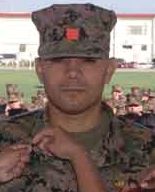
The "Red Patch" is a distinguishing marking worn by United States Marines of the Logsitcs Specialist (0441) MOS. [1]

The "Red Patch" is a distinguishing marking worn by United States Marines of the Logsitcs Specialist (0441) MOS. [1]
The red patch dates back to the early days of WWII during the Battle of Guadalcanal. After the initial assault on the beachhead, follow-on troops came ashore and confusion on the beach led to landing support Marines (then known as shore party) and infantrymen getting mixed together. Some shore party Marines went inland along with infantry battalions, while some infantrymen were left behind on the beach. It is not known for certain who made the decision, but a device was created in order to distinguish the shore party Marines: a red patch on the trousers and hat, referred to by Marines as a cover, (a patch was not put on the blouse because many Marines did not wear them due to the heat of the South Pacific). Around the same time, Naval Shore Parties, now known as Beachmaster Unit One began to wear yellow patches on their uniforms, as they do today.
Shore party Marines were either assigned to pioneer battalions or as part of an infantry battalion's shore party. Pioneer battalions consisted of shore party Marines, combat engineers, and heavy equipment operators and were in charge of establishing beach support areas in the Pacific Theater of World War II. Pioneer battalions were sometimes used to relieve infantry battalions on the front lines and were often involved in heavy fighting in places such as Bloody Ridge on Guadalcanal. One of the more notable shore party Marines was 1st Lt. Alexander Bonnyman Jr., executive officer of the 2nd Battalion 8th Marines' Shore Party, who received the Medal of Honor for his actions during the Battle of Tarawa.
The red patch measures 3 in × 1 in (7.6 cm × 2.5 cm) on the trousers, worn 2.5 in (6.4 cm) below the cargo pocket, centered, and 1 in × 1 in (2.5 cm × 2.5 cm) on the front of the eight point cover, centered. A 1 in × 1 in (2.5 cm × 2.5 cm) patch is supposed to be worn on the front and rear of the Kevlar helmet, but this practice has fallen into disuse.

The 81st Readiness Division ("Wildcat") was a formation of the United States Army originally organized as the 81st Infantry Division during World War I. After World War I, the 81st Division was allotted to the Organized Reserve as a "skeletonized" cadre division. In 1942, the division was reactivated and reorganized as the 81st Infantry Division and served in the Pacific during World War II. After World War II, the 81st Infantry Division was allotted to the Organized Reserve as a Class C cadre division, and stationed at Atlanta, Georgia. The 81st Infantry Division saw no active service during the Cold War and was inactivated in 1965.
The School of Infantry (SOI) is the second stage of initial military training for enlisted United States Marines after recruit training. The ITB now called IMC went from a 59 day course to 14 week course. Since the initial training pipeline is divided between coasts, Marines from areas east of the Mississippi River usually graduate from MCRD Parris Island and move on to SOI at SOI East, while those from the western half of the nation attend MCRD San Diego and move on to SOI West at the Camp San Onofre area of Camp Pendleton in California. Female Marines are trained at both SOI East and SOI West. The School of Infantry's training mission ensures "Every Marine is, first and foremost, a Rifleman". At SOI, Marines with the Military Occupational Specialty of infantry are trained at the Infantry Training Battalion (ITB), while all non-infantry Marines are trained in basic infantry and combat skills at the Marine Combat Training Battalion. SOI marks a transition in the professional training of entry-level students from basically trained Marines to combat-ready Marines.

The 1st Marine Division is a Marine division of the United States Marine Corps headquartered at Marine Corps Base Camp Pendleton, California. It is the ground combat element of the I Marine Expeditionary Force.
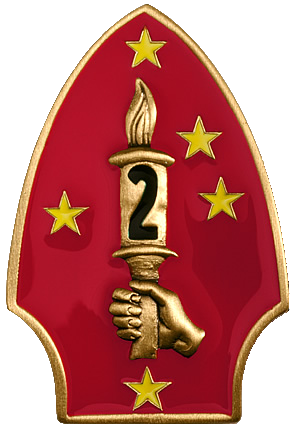
The 2nd Marine Division is a division of the United States Marine Corps, which forms the ground combat element of the II Marine Expeditionary Force. The division is based at Marine Corps Base Camp Lejeune, North Carolina and headquartered at Julian C. Smith Hall.
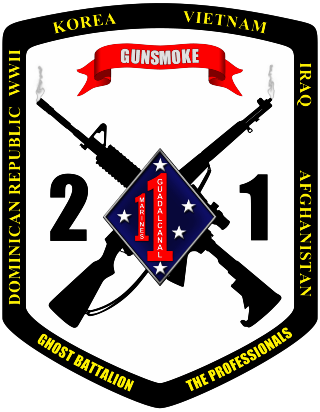
2nd Battalion, 1st Marines (2/1) is an infantry battalion in the United States Marine Corps based in Camp HORNO on Marine Corps Base Camp Pendleton, California. Nicknamed "The Professionals," the battalion consists of approximately 1,200 Marines and Sailors. Normally they fall under the command of the 1st Marine Regiment and the 1st Marine Division.

1st Battalion, 5th Marines (1/5) is an infantry battalion in the United States Marine Corps based out of Marine Corps Base Camp Pendleton, California consisting of approximately 800 Marines and sailors. Nicknamed Geronimo, it falls under the command of the 5th Marine Regiment and the 1st Marine Division. The battalion was formed in 1914 and has served in every major conflict that the United States has been involved in since then.

The 3rd Battalion 7th Marine Regiment (3/7) is an infantry battalion of the United States Marine Corps. They are based at the Marine Corps Air Ground Combat Center Twentynine Palms and consist of approximately 800 Marines. The battalion falls under the command of the 7th Marine Regiment and the 1st Marine Division. The battalion has seen combat in World War II, the Korean War, the Vietnam War, the Gulf War and was a part of the main effort during the initial invasion of Iraq in 2003. During the Global War on Terror, the battalion saw eleven sequential combat deployments; five in support of Operation Iraqi Freedom, three in support of Operation Enduring Freedom, and three in support Operation Inherent Resolve. The unit has a long, decorated history with countless achievements. Its members were described as "true professionals" by embedded reporters during the 2003 invasion of Iraq.

The 3rd Reconnaissance Battalion conducts amphibious and ground reconnaissance in support of the 3rd Marine Division and Marine Forces Pacific (MarForPac), operating in the commander's areas of influence. The battalion is based out of Camp Schwab, a satellite base of Marine Corps Base Camp Smedley D. Butler. It is geographically located on the Okinawa Prefecture in Japan.
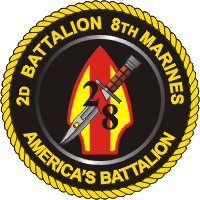
2nd Battalion, 8th Marines (2/8) is an infantry battalion in the United States Marine Corps based in Marine Corps Base Camp Lejeune, North Carolina consisting of approximately 900 marines and sailors. Nicknamed "America's Battalion," they fall under the 8th Marine Regiment and the 2nd Marine Division.

The 23rd Marine Regiment is a reserve infantry regiment of the United States Marine Corps. It is headquartered in San Bruno, California and falls under the command of the 4th Marine Division and the Marine Forces Reserve.

2nd Battalion, 23rd Marines (2/23) is a reserve infantry battalion in the United States Marine Corps located throughout the Western United States consisting of approximately 1000 Marines and Sailors. They fall under the command of the 23rd Marine Regiment and the 4th Marine Division.

Combat Logistics Regiment 3 (CLR-3) is a direct support (DS) logistics unit of the United States Marine Corps and is headquartered at Camp Foster, Okinawa, Japan. The unit falls under the 3rd Marine Logistics Group and the III Marine Expeditionary Force.
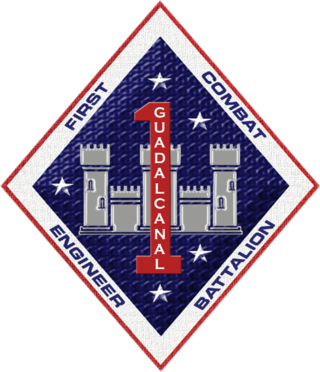
1st Combat Engineer Battalion is a combat engineer battalion of the United States Marine Corps. The unit, nicknamed "The Super Breed", is based at Marine Corps Base Camp Pendleton, California and falls under the command of the 1st Marine Division and the I Marine Expeditionary Force.

The 3rd Battalion, 9th Marines (3/9) is an infantry battalion of the United States Marine Corps. Formed during World War I it served until the early 1990s when it was redesignated as 3rd Battalion, 4th Marines (3/4) during a realignment and renumbering of the Marine Corps' infantry battalions, following the deactivation of the 9th Marine Regiment. The 3rd Battalion, 9th Marines was initially a subordinate unit of the 9th Marine Regiment, 3rd Marine Division, but was later operationally transferred to the 1st Marine Division as a subordinate unit of the 7th Marine Regiment where it remained until its redesignation as 3/4.

The United States Marine Corps (USMC) prescribes several types of military uniform to distinguish its service members from other armed services, depending on the situation.

A pioneer is a soldier employed to perform engineering and construction tasks. The term is in principle similar to sapper or combat engineer.
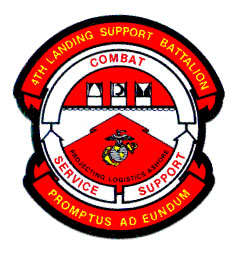
4th Landing Support Battalion(4th LSB) was a Military Landing Support battalion of the United States Marine Corps Reserve. The unit was based out of New Orleans, Louisiana, and fell under the command of the 4th Marine Logistics Group. The Battalion has been decommissioned.

Naval Mobile Construction Battalion 133 is a United States Navy Construction Battalion, otherwise known as a Seabee battalion, homeported at the Naval Construction Battalion Center. The unit was formed during WWII as the 133rd Naval Construction Battalion. It saw action and was decommissioned shortly after the war ended. The unit was reactivated as Mobile Construction Battalion 133 for the Vietnam War and remains an active unit today.

The Landing Craft, Mechanized Mark 2 or LCM (2) was a landing craft used for amphibious landings early in the United States' involvement in the Second World War. Though its primary purpose was to transport light tanks from ships to enemy-held shores, it was also used to carry guns and stores. The craft was designed by the Navy's Bureau of Construction and Repair and the initial production contract was let to the American Car & Foundry Company. A total of 147 were built by this company and Higgins Industries. Because of its light load capacity and the rapid production of the superseding LCM (3), the LCM (2) quickly fell out of use following the Allied invasion of North Africa in 1942.
2d Landing Support Battalion(2d LSB) is a logistics battalion in the United States Marine Corps that supports distributed maritime operations and expeditionary advanced base operations. The unit is based out of Marine Corps Base Camp Lejeune, North Carolina and falls under the command of the 2nd Marine Logistics Group and the II Marine Expeditionary Force.
![]() This article incorporates public domain material from websites or documents of the United States Marine Corps .
This article incorporates public domain material from websites or documents of the United States Marine Corps .